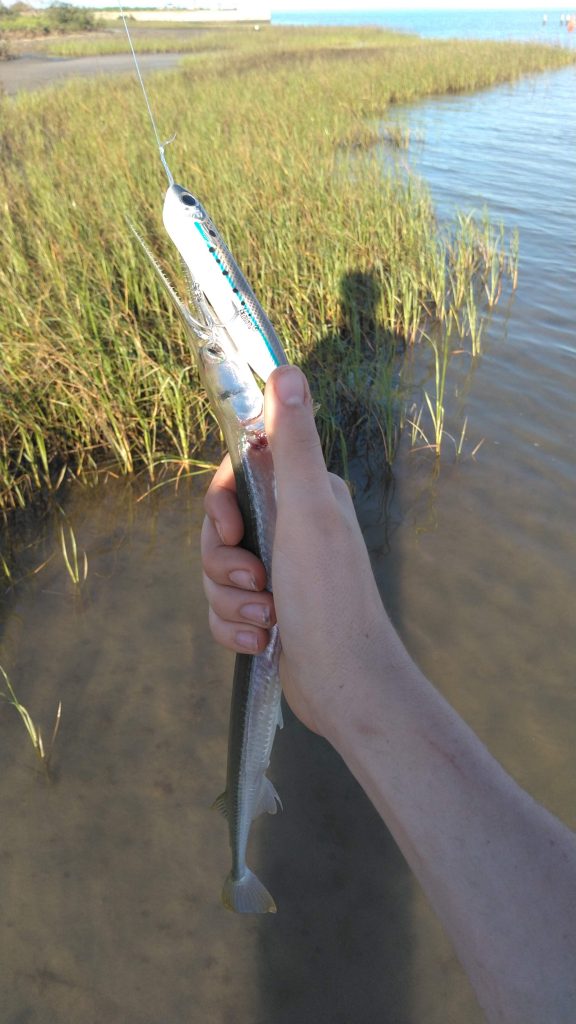Visiting Port O’Connor

The morning before our arrival, we left our campsite at Lake Corpus Christie and headed toward the coast. After driving for a few hours, we came to a small town and one of the first things I noticed was that the houses were on stilts. Due to the frequent storms and flooding in the area, houses are built up an extra story with wooden piles below to support them. It’s not the most compelling thing we saw, but still I found it interesting; furthermore, Port O’Connor is a vacation destination in Texas so some of these houses were impressive (figure 1).
After driving through town, we came to a small boathouse and dock where we met Cooper Knight. Cooper, a friend of Casey’s, worked for him when they were both in college. He owned a boat and was going to be our guide for the area. After listening to Cooper tell us about all the ways we could potentially die on the trip, we unloaded our luggage from the U-Haul and started packing the boat that would take us to Matagorda Island, an eleven-mile barrier island about 10 miles off the Texas Coast.
Cooper later explained that Matagorda Island had an interesting history. It housed a lighthouse that was used during the Civil War, which was supposed to have been blown up by the Confederacy but survived the blast. In an attempt to thwart the invading Union army, the last Confederate soldiers on the island hid the light’s lens in the sand, where it stayed covered until it was found years later and put in a museum. Later in its life the island was used as a military base,

and still has the old barracks and runway from the 1950’s. In its current state, it is a Wildlife Management Area, run by Texas Parks and Wildlife (figure 2)
After reaching the dock and setting up camp (figure 3), a lot of us decided to try fishing. Using dead shrimp as bait, we cast along the concrete walls surrounding the docks. We got bites almost immediately and started catching saltwater hardhead catfish and other smaller prey fish. A few of us attempted to use cut bait instead of shrimp hoping for something bigger, and I did catch a larger species of catfish called a gaftop. Cooper went fishing from the docks and caught an eel, which was cool to see, while Emily, using a cast net, caught a flounder.
After it got too dark to fish, I joined some of the others who were still throwing the cast net. Being illegal to use in North Dakota, I had never thrown one and soon learned it’s not as easy as it looks. We ended up catching a blue crab but not much else.
Later that night, we had a shrimp boil, something Casey had been working on all afternoon and evening. The fresh shrimp was some of the best seafood I’ve ever had, and I was grateful Casey had done that for us. I ended up eating way too much and went to bed early.
The next morning, I woke up and fished. Unfortunately, while Spencer caught something like 40 trout, I wasn’t having much luck. I did eventually catch a few catfish and a needlefish, which bit

me when I tried to release it (figure 4).
Later that afternoon, we climbed on Cooper’s boat and, along with local fish expert, Dusty McDonald, went seining. Our first stop was a barrier island, where the ocean meets the brackish water. The real Gulf of Mexico doesn’t start right at the Texas coast but actually begins past all the sand bars and barrier islands that run parallel to Texas. It’s pretty crazy to see the calm water on which we are traveling suddenly disappear and give way to large crashing waves. There’s a small island that separates the two, but until you get close you can’t see it (figure 5). We stopped at that island and pulled a seine net through the shallow water but only caught a few fish. That wasn’t really important to me though, because this was the first time I had been in the ocean, so that in
itself was a great experience. We tried a few more spots in the shallower water and caught a large variety of fish, including a pipefish, which is related to a seahorse. After sampling we returned to the island, where we packed and left for the mainland.


